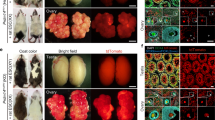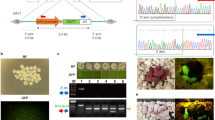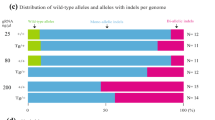Abstract
The use of homologous recombination to modify genes in embryonic stem (ES) cells provides a powerful means to elucidate gene function and create disease models1. Application of this technology to engineer genes in rats has not previously been possible because of the absence of germline-competent ES cells in this species. We have recently established authentic rat ES cells2,3. Here we report the generation of gene knockout rats using the ES-cell-based gene targeting technology. We designed a targeting vector to disrupt the tumour suppressor gene p53 (also known as Tp53) in rat ES cells by means of homologous recombination. p53 gene-targeted rat ES cells can be routinely generated. Furthermore, the p53 gene-targeted mutation in the rat ES-cell genome can transmit through the germ line via ES-cell rat chimaeras to create p53 gene knockout rats. The rat is the most widely used animal model in biological research4,5,6,7. The establishment of gene targeting technology in rat ES cells, in combination with advances in genomics and the vast amount of research data on physiology and pharmacology in this species, now provide a powerful new platform for the study of human disease.
This is a preview of subscription content, access via your institution
Access options
Subscribe to this journal
Receive 51 print issues and online access
$199.00 per year
only $3.90 per issue
Buy this article
- Purchase on Springer Link
- Instant access to full article PDF
Prices may be subject to local taxes which are calculated during checkout




Similar content being viewed by others
References
Capecchi, M. R. Gene targeting in mice: functional analysis of the mammalian genome for the twenty-first century. Nature Rev. Genet. 6, 507–512 (2005)
Buehr, M. et al. Capture of authentic embryonic stem cells from rat blastocysts. Cell 135, 1287–1298 (2008)
Li, P. et al. Germline competent embryonic stem cells derived from rat blastocysts. Cell 135, 1299–1310 (2008)
Gill, T. J., III, Smith, G. J., Wissler, R. W. & Kunz, H. W. The rat as an experimental animal. Science 245, 269–276 (1989)
Jacob, H. J. Functional genomics and rat models. Genome Res. 9, 1013–1016 (1999)
Aitman, T. J. et al. Progress and prospects in rat genetics: a community view. Nature Genet. 40, 516–522 (2008)
Jacob, H. J. & Kwitek, A. E. Rat genetics: attaching physiology and pharmacology to the genome. Nature Rev. Genet. 3, 33–42 (2001)
Kitada, K. et al. Transposon-tagged mutagenesis in the rat. Nature Methods 4, 131–133 (2007)
Izsvák, Z. et al. Generating knockout rats by transposon mutagenesis in spermatogonial stem cells. Nature Methods 7, 443–445 (2010)
Zan, Y. et al. Production of knockout rats using ENU mutagenesis and a yeast-based screening assay. Nature Biotechnol. 21, 645–651 (2003)
Geurts, A. M. et al. Knockout rats via embryo microinjection of zinc-finger nucleases. Science 325, 433 (2009)
Cozzi, J. et al. Pronuclear DNA injection for the production of transgenic rats. Methods Mol. Biol. 561, 73–88 (2009)
Lu, B. et al. Generation of rat mutants using a coat color-tagged Sleeping Beauty transposon system. Mamm. Genome 18, 338–346 (2007)
Mashimo, T. et al. Generation of knockout rats with X-linked severe combined immunodeficiency (X-SCID) using zinc-finger nucleases. PLoS ONE 5, e8870 (2010)
Ying, Q. L. et al. The ground state of embryonic stem cell self-renewal. Nature 453, 519–523 (2008)
Levine, A. J., Momand, J. & Finlay, C. A. The p53 tumour suppressor gene. Nature 351, 453–456 (1991)
McCarrick, J. W. III, Parnes, J. R., Seong, R. H., Solter, D. & Knowles, B. B. Positive-negative selection gene targeting with the diphtheria toxin A-chain gene in mouse embryonic stem cells. Transgenic Res. 2, 183–190 (1993)
Liu, X. et al. Trisomy eight in ES cells is a common potential problem in gene targeting and interferes with germ line transmission. Dev. Dyn. 209, 85–91 (1997)
Nagy, A., Rossant, J., Nagy, R., Abramow-Newerly, W. & Roder, J. C. Derivation of completely cell culture-derived mice from early-passage embryonic stem cells. Proc. Natl Acad. Sci. USA 90, 8424–8428 (1993)
Hughes, E. D. et al. Genetic variation in C57BL/6 ES cell lines and genetic instability in the Bruce4 C57BL/6 ES cell line. Mamm. Genome 18, 549–558 (2007)
Adams, D. J. & van der Weyden, L. Contemporary approaches for modifying the mouse genome. Physiol. Genomics 34, 225–238 (2008)
Kuhn, R. & Torres, R. M. Cre/loxP recombination system and gene targeting. Methods Mol. Biol. 180, 175–204 (2002)
Belteki, G. et al. Conditional and inducible transgene expression in mice through the combinatorial use of Cre-mediated recombination and tetracycline induction. Nucleic Acids Res. 33, e51 (2005)
Feil, R. Conditional somatic mutagenesis in the mouse using site-specific recombinases. Handb. Exp. Pharmacol. 178, 3–28 (2007)
Nagy, A., Gertsenstein, M., Vintersten, K. & Behringer, R. Manipulating the Mouse Embryo, a Laboratory Manual 3rd edn (Cold Spring Harbor Laboratory Press, 2003)
Tybulewicz, V. L., Crawford, C. E., Jackson, P. K., Bronson, R. T. & Mulligan, R. C. Neonatal lethality and lymphopenia in mice with a homozygous disruption of the c-abl proto-oncogene. Cell 65, 1153–1163 (1991)
Niwa, H., Yamamura, K. & Miyazaki, J. Efficient selection for high-expression transfectants with a novel eukaryotic vector. Gene 108, 193–199 (1991)
Ying, Q. L., Nichols, J., Chambers, I. & Smith, A. BMP induction of Id proteins suppresses differentiation and sustains embryonic stem cell self-renewal in collaboration with STAT3. Cell 115, 281–292 (2003)
Sambrook, J. & Russell, D. W. Molecular Cloning: a Laboratory Manual (Cold Spring Harbor Laboratory press, 2001)
Acknowledgements
This work was supported by a NIH/NCRR grant to Q.-L.Y. (1R01 RR025881). We thank members of the Ying laboratory and the USC Stem Cell Core for technical assistance; G. Chester for ordering rats; R. Montano and colleagues for rat husbandry; T. Saunders, E. Bryda and M. Pera for critical reading of the manuscript; E. Kho for financial support. We are also grateful to M. Pera and R. Maxson for their support and encouragement.
Author information
Authors and Affiliations
Contributions
C.T. designed and performed most of the experiments described in the paper. P.L. and Q.-L.Y. derived and cultured rat ES cells. N.L.W. and Y.Y. performed blastocyst injections. Q.-L.Y. conceived the study and wrote the paper.
Corresponding author
Ethics declarations
Competing interests
Q.L.Y. is an inventor on a patent relating to this study filed by the University of Edinburgh and licensed to StemCells Inc.
Additional information
The p53 gene-targeted rats generated in this study will be deposited in the Rat Resource and Research Center at University of Missouri.
Supplementary information
Supplementary Information
This file contains Supplementary Table 1 and Supplementary Figures 1-5. (PDF 371 kb)
Rights and permissions
About this article
Cite this article
Tong, C., Li, P., Wu, N. et al. Production of p53 gene knockout rats by homologous recombination in embryonic stem cells. Nature 467, 211–213 (2010). https://doi.org/10.1038/nature09368
Received:
Accepted:
Published:
Issue Date:
DOI: https://doi.org/10.1038/nature09368
This article is cited by
-
Blastocyst complementation using Prdm14-deficient rats enables efficient germline transmission and generation of functional mouse spermatids in rats
Nature Communications (2021)
-
Efficient derivation of knock-out and knock-in rats using embryos obtained by in vitro fertilization
Scientific Reports (2019)
-
Radiation-induced malignancies after intensity-modulated versus conventional mediastinal radiotherapy in a small animal model
Scientific Reports (2019)
-
Pluripotent stem cell-derived organogenesis in the rat model system
Transgenic Research (2019)
-
Successful production of genome-edited rats by the rGONAD method
BMC Biotechnology (2018)
Comments
By submitting a comment you agree to abide by our Terms and Community Guidelines. If you find something abusive or that does not comply with our terms or guidelines please flag it as inappropriate.



